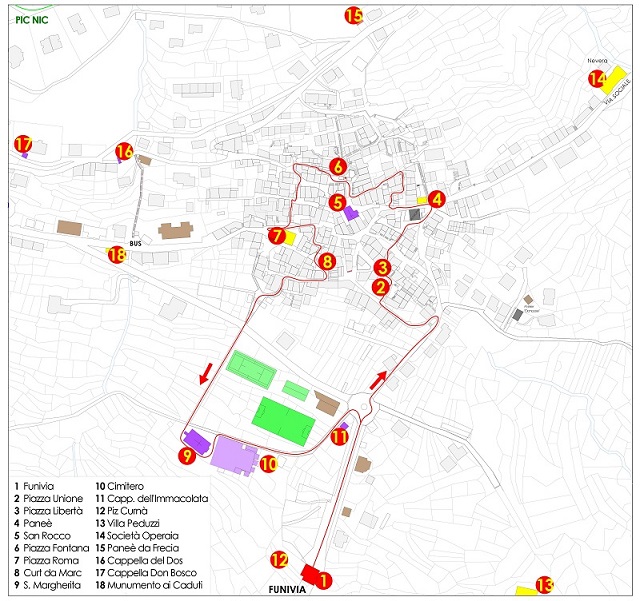 La Provincia di giovedì 12 Novembre 2015 ha pubblicato un bellissimo articolo di Francesco Aita sul Pigra ed in particolare sulla nostra iniziativa Pigra da Scoprire
La Provincia di giovedì 12 Novembre 2015 ha pubblicato un bellissimo articolo di Francesco Aita sul Pigra ed in particolare sulla nostra iniziativa Pigra da Scoprire
qui in seguito una trascrizione del testo dell'articolo

"C'è Pigra da scoprire"
Quel Paese rinato grazie alla sua funivia
La storia. L'associazione degli Amici e il Comune hanno preparato un itinerario destinato ai turisti. Migliaia di persone attratte dal Belvedere e dai vicoli
PIGRA - di FRANCESCO AITA
Paesaggio, storia, cultura, arte e tradizione. «Pigra da scoprire», un itinerario in posizione panoramica e dominante a quota 870 metri di altitudine, tutto da gustare che rappresenta un viaggio culturale, testimonianza di una comunità viva.
Un progetto di divulgazione e valorizzazione del patrimonio, tipico paesaggio alpino e rurale, portata avanti dall'associazione Amici di Pigra sostenuto dall'amministrazione comunale, diventato un volano turistico indispensabile per la crescita del territorio.
Merito, naturalmente, anche della splendida funivia che collega Argegno con Pigra.
Cartelli, pannelli didattici, indicazioni, si snodano tra i viottoli del centro storico. La «risciada», ossia il vecchio acciottolato in pietra, ci conduce tra i tesori architettonici e urbanistici nel cuore del vecchio borgo. Uno scenario di rara bellezza, le piazzette, con le case ben tenute, addossate uno all’altra, le fontane, scalinate, portali, antichi cortili, portici, edicole votive, dipinti, meridiane, le facciate in terre naturali e sasso a vista, non contaminato dall’uso dell'auto che ci riporta lontano alle bellezze di un tempo, che i secoli non hanno scalfito.
Dimore medievali con le finestre «bifore» ben conservate fanno di Pigra un vero e proprio monumento alla storia.
Un viaggio culturale, apprezzato da migliaia di visitatori che ha fatto di Pigra in questi ultimi anni un piccolo paese di grande richiamo culturale.
L’iniziativa delle associazioni locali, rappresenta un impegno progettuale che ha avuto inizio con il recupero del Belvedere, uno tra i siti panoramici che guarda il Lario tra i più suggestivi di tutto il territorio Lariano, il balcone mozzafiato con il binocolo d'osservazione a ridosso della funivia e si è concluso con il recupero della chiesa di Santa Margherita.
Un’idea di cultura, espressione dinamica di un nutrito gruppo di volontari, residenti e villeggianti che liberamente si aggregano, promuovendo per passione e per amore del posto in cui vivono o trascorrono le vacanze, le specificità del territorio.
E la valorizzazione del patrimonio storico e monumentale, fondamento delle radici e della memoria storica e delle tradizioni delle comunità, inserita in un contesto naturale e ambientale già di per se stesso generoso.
Luoghi di antico fascino che ci riportano ai resti delle antiche torri e fortificazioni che fanno risalire l'origine della comunità all’epoca tardo romana.
Mete visitate, la chiesa di Santa Margherita di antica fondazione, l'Oratorio di Sam Rocco, la biblioteca civica particolarmente ricca di testimonianze sulle opere e la storia dei Magìstri Intelvesi.
Di elevato valore storico e sociale la sede della società operaia di mutuo soccorso che vanta tra i suoi primi aderenti anche Giuseppe Garibaldi.
Pigra da Scoprire
4 - Il Panée da l'Alp (1886)
 Il Panée da l'Alp (lavatoio) è la fontana di Pigra che non è mai rimasta senz'acqua.
Il Panée da l'Alp (lavatoio) è la fontana di Pigra che non è mai rimasta senz'acqua.
Luogo di ritrovo e di conversazione per le donne del Paese che, non avendo l'acqua corrente in casa, lì erano costrette a recarsi a tutte le ore a lavare il bucato.
Punto d'incontro dove nascevano e si alimentavano i più svariati pettegolezzi.
Anche dopo la costruzione del Basin da Frecia (acquedotto comunale) il Panée da l'Alp è rimasto per anni l'unica sorgente del Paese sempre in uso.
Curiosità
Nei periodi estivi quando scarseggiava l'acqua a causa dei numerosi villeggianti, qui si formavano lunghe code che a volte sfociavano in liti e discussioni.
Si racconta che laGiana grande lavoratrice, per non sprecare tempo sferruzzava a maglia in attesa del proprio turno riuscendo a confezionare l'intera manica di un golfino.
 The Panée da l'Alp (washtub) is Pigra’s fountain, whose water has always been running.
The Panée da l'Alp (washtub) is Pigra’s fountain, whose water has always been running.
The washtub was the meeting point of the village women who had to go there to do the laundry several times per day, since there was no running water in their houses.
At the washtub, the women used to have all sorts of conversations and this is the place where all the village gossip originated.
Even after the construction of the Basin da Frecia(town aqueduct), the Panée da l'Alp remained for years the only water spring of the village where all the people wanted to go to.
Curiosities
In summer time, when the village was taken over by tourists and hence the water was less, in front of the washtub, there were long queues that eventually turned into discussions and fights. People say that Giana, the great worker, in order not to waste time on the queue for water, used to knit a whole jumper sleeve while waiting.
 Der Panée da l'Alp (1886)
Der Panée da l'Alp (1886)
Der Panée da l'Alp (Waschtrog) ist der Brunnen von Pigra, in dem noch nie das Wasser versiegt ist.
Ort der Zusammenkunft und des Gesprächs für die Frauen des Dorfs, die zu jeder Tageszeit gezwungen waren, hierher zu kommen, um ihre Wäsche zu waschen, als es in den Häusern noch kein fließendes Wasser gab.
Der Treffpunkt, an dem allerlei Geschichten und Gerüchte ins Leben gerufen und weitererzählt wurden.
Auch nach dem Bau des Basin da Frecia (kommunales Aquädukt) war der Panée da l'Alpnoch jahrelang die einzige Quelle im Dorf, die immer in Gebrauch war.
Kurioses
In den Sommermonaten, in denen das Wasser wegen der vielen Urlauber knapp war, bildeten sich hier lange Schlangen, in denen hin und wieder auch Streit und Diskussionen aufkamen.
Es wird erzählt, dass Giana, eine harte Arbeiterin, immer ihr Strickzeug zur Hand nahm, um keine Zeit zu verschwenden, während sie darauf wartete, an der Reihe zu sein, und bei der Gelegenheit nicht selten einen Jackenärmel zustande brachte.
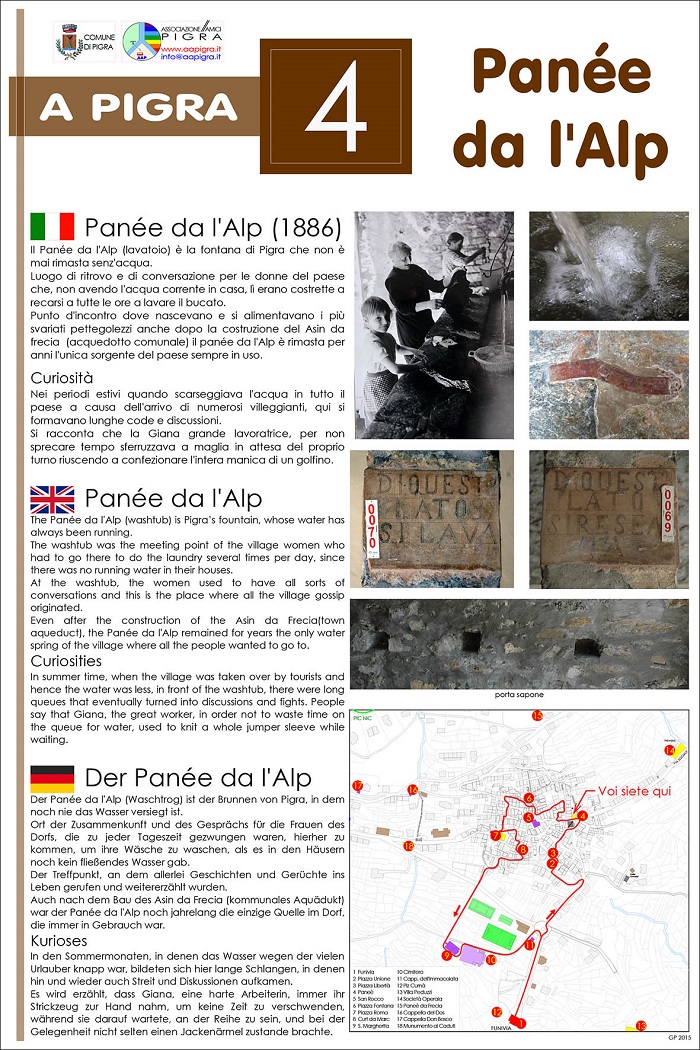
 Pigra da Scoprire
Pigra da Scoprire
5 - Oratorio di San Rocco

Di origine rinascimentale, il piccolo oratorio è stato oggetto di recente restauro: vi si notano le medesime decorazioni a stucco che abbelliscono la parrocchiale di Santa Margherita.
Esternamente, nella semplicissima facciata a capanna, si aprono due finestre ornate da inferriate recenti.
L’interno è a una sola navata; il presbiterio, a pianta rettangolare, ospita nella nicchia di destra, una statua lignea di San Rocco, di autore ignoto del seicento. Il Santo con il fido cagnolino ai suoi piedi, addita la ferita con la mano sinistra. La statua misura cm 42 x 105.
Interessante è il tondo rinascimentale in marmo raffigurante la Madonna col Bambino, inglobato nel recente altare maggiore: si tratta di un reimpiego forse proveniente dalla primitiva decorazione della chiesa.
La parete di fondo reca un affresco in tre quadri, da 15O, 180, l50 cm, alti 265 cm.
Vi sono raffigurati, al centro, la Vergine con San Rocco e San Sebastiano, a sinistra San Domenico e Santo Stefano, a destra San Pietro Martire e San Giovanni Battista.
Un'iscrizione posta al di sotto ricorda che le figure furono commissionate dai fratelli Stefano e Domenico Riva nel 1662 al pittore Salvatore Pozzi.

The Renaissance oratory has been recently restored and you are now able to admire the beautiful ornamental decorations that characterize Saint Margaret Parish church.
Externally, on the simple Romanic styled façade, we can see two windows whose gratings are recent.
Inside, the oratory features a single central nave and on the right corner of the rectangular presbytery there is a XV century wood statue of Saint Rocco.
The Saint, who is along his trusted little dog, points at the wound with his left hand.
The statue measures cm 42 x cm105.
The greater altar comprises a Renaissance marble tondo representing the Virgin Mary with the baby: this might be a reuse from the previous decoration of the church.
On the furthest wall there is a fresco divided in three parts of respectively 15O, 180, l50 cm wide and 265 cm high.
In the central part of the fresco, we can see the Virgin Mary with Saint Rocco and Saint Sebastiano; on the left we have Saint Domenico and Saint Stefano, while on the right side there are Saint Pietro Martire and San Giovanni Battista.
An inscription placed below the fresco states that the figures were commissioned to the painter Salvatore Pozzi in 1662 by the Riva brothers (Stefano and Domenico).
 Das kleine Oratorium aus der Renaissance wurde erst kürzlich renoviert: Wir sehen hier dieselben Stuckdekorationen, die auch die Pfarrkirche Santa Margherita schmücken.
Das kleine Oratorium aus der Renaissance wurde erst kürzlich renoviert: Wir sehen hier dieselben Stuckdekorationen, die auch die Pfarrkirche Santa Margherita schmücken.
Außen öffnen sich in der sehr schlichten Fassade mit kleinem Spitzdach zwei Fenster, die mit Eisengittern jüngeren Datums verziert sind.
Der Innenraum hat nur ein Schiff; in der rechten Nische des Presbyteriums mit rechteckigem Grundriss steht die Holzstatue vom Heiligen Rochus eines unbekannten Künstlers aus dem siebzehnten Jahrhundert. Der Heilige mit seinem treuen kleinen Hund zu seinen Füßen weist mit der linken Hand auf die Wunde. Die Statue misst 42 x 105.
Interessant ist das marmorne Rundbild aus der Renaissance mit Madonna mit Kind im weniger alten Hochaltar: Es handelt sich möglicherweise um die Wiederverwendung der ursprünglichen Dekoration der Kirche.
An der Rückwand hängt ein Fresko in drei Bildern, die jeweils 15O, 180, l50 cm breit und 265 cm hoch sind.
In der Mitte ist die Heilige Jungfrau mit den Heiligen St. Rochus und St. Sebastian dargestellt, links St. Dominikus und St. Stephanus und rechts St. Petrus Martyr und St. Johannes-Baptist.
Darunter erinnert eine Inschrift daran, dass die Bilder von den Brüdern Stefano und Domenico Riva 1662 dem Maler Salvatore Pozzi in Auftrag gegeben worden waren.
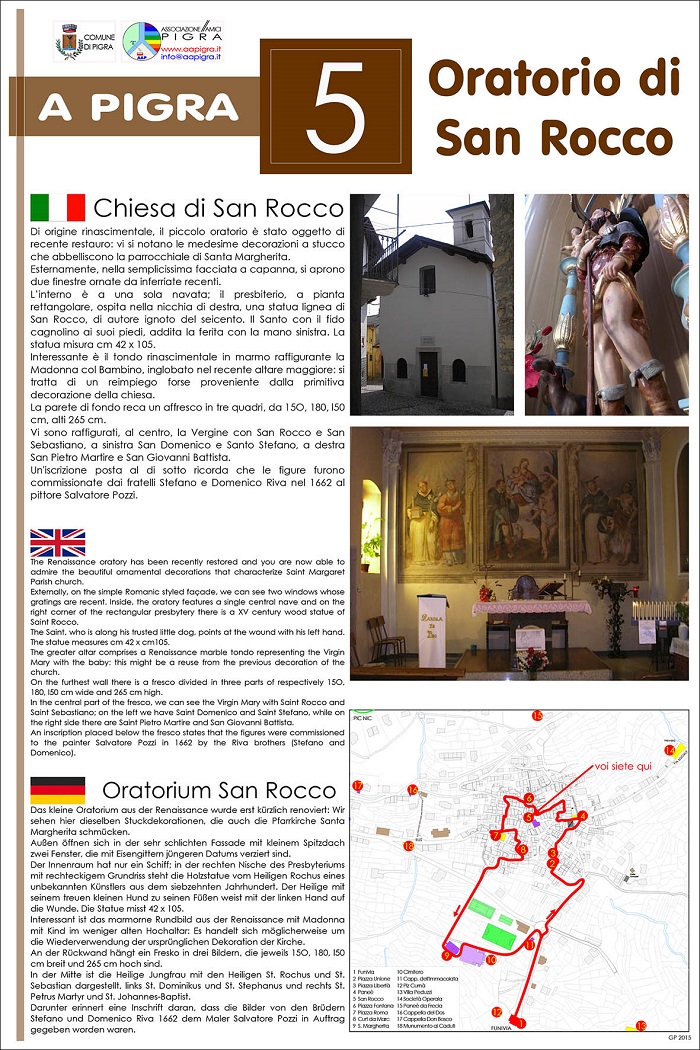
Pigra da Scoprire
7 - Piazza Roma
 È sempre stata il cuore di ogni attività anche mondana di Pigra.
È sempre stata il cuore di ogni attività anche mondana di Pigra.
Su di essa si affacciavano la cooperativa di generi alimentari e un bar.
Questo era il luogo di ritrovo degli emigranti prima di lasciare il paese ed anche il punto in cui si svolgevano le celebrazioni e le ricorrenze pubbliche discutendo animatamente di tutto, dalla politica allo sport senza trascurare i pettegolezzi.
Nelle sere d’estate da qui si diffondeva la musica della banda del paese che richiamava tutti
Pigresi e villeggianti per far festa.
ll Muretto e la ringhiera erano sempre affollati e la piazza era anche il parco giochi per i bambini che giocando a palla a volte suscitavano l'ira dei gestori della cooperativa rompendo qualche vetro... naturalmente ad opera del signor "Mi no" (non sono stato io).
 It always was the heart of every activity in Pigra with its cooperative grocery and a bar.
It always was the heart of every activity in Pigra with its cooperative grocery and a bar.
This was the meeting point for emigrants before leaving the village and also where took place important celebrations and public meetings. People talked about politics, sports without neglecting the gossip.
The wall and the railings were always crowded and the square was also the playground for children that playing ball sometimes caused damages as broken glass... but without the possibility to find the guilty...
Pizza Roma war stets der Mittelpunkt von Pigra.
Hier gab es einen Lebensmittelladen und ein Café.
Der Platz war Treffpunkt der Auswanderer, die das Dorf verlassen haben, aber auch ein Ort, an dem diverse Feierlichkeiten stattfanden. Hier wurde über alles geredet: Politik, Sport, aber vor allem frönte man hier dem Dorfklatsch.
An Sommerabenden spielte die Dorfkapelle und Dorfbewohner und Touristen trafen sich zum Feiern.
Auf der kleinen Steinmauer saßen immer viele Leute und Piazza Roma diente auch als Spielplatz für Ball spielende Kinder, die ab und an auch mal ein Fenster kaputtmachten und daher bei den Geschäftsleuten nicht allzu beliebt waren.
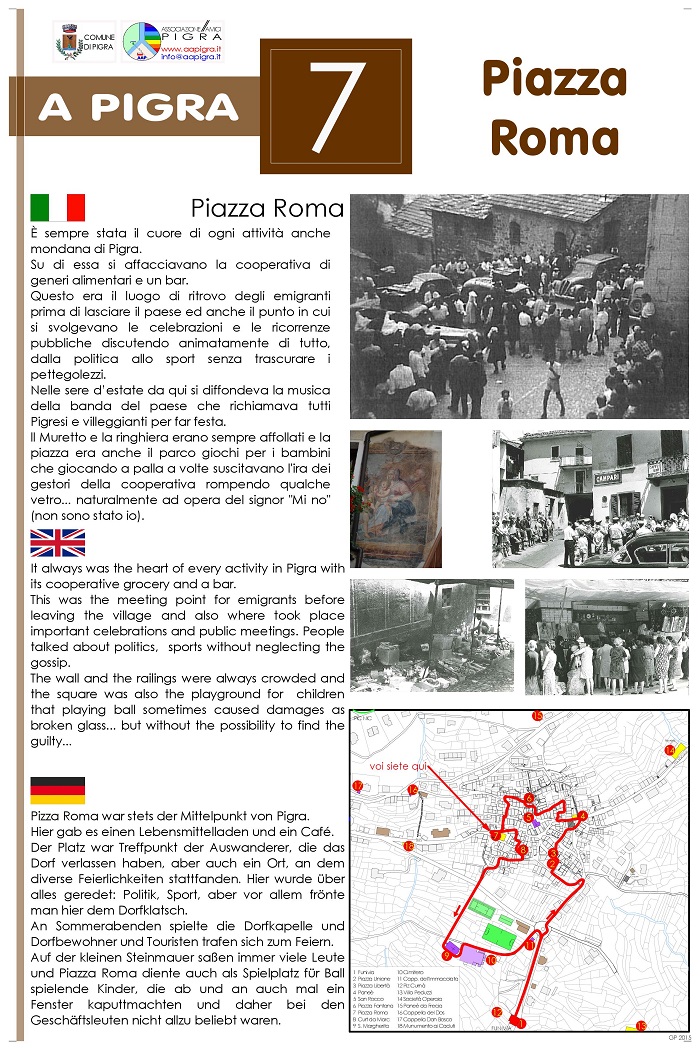
Pigra da Scoprire
9 - Santa Margherita

La chiesa di Santa Margherita con campanile e sacrestia è vicina al cimitero . Sul prospetto principale vi è un protiro con due colonne in serizzo e vela affrescata; i prospetti della Chiesa sono scanditi da lesene in specchiature geometriche con zoccolo intonacato e dipinto.
La Chiesa sembra essere di origine romanica , molto rimaneggiata nel corso dei secoli passando dalle due alle attuali tre navate nel 1669; il presbiterio a forma poligonale, risale al 1757.
Sono del '600 le tre tele, entro stucchi, dell'abside raffiguranti il Crocifisso con i SS Carlo e Francesco, i SS Agnese, Antonio Abate, Domenico e l'incredulità di San Tommaso; la tela con i tre santi è documentata come pala dell'altare maggiore della Chiesa antica.
La volta novecentesca raffigura gli Evangelisti e la Gloria dell'Eucarestia, anche l'altare maggiore è della stessa epoca.
In fondo alla navata di destra troviamo un pregiato paliotto a cassaforte in scagliola opera di Andrea Solari; nella nicchia sopra l'altare la statua di Santa Margherita, patrona di Pigra.
Nella navata di sinistra si trova un altro altare sotto il quale vi è la statua della Madonna in fasce (Maria Bambina) al di sopra la statua della Vergine sormontata da un baldacchino finemente lavorato, la balaustra è datata 1678.
Il paliotto è costituito da tre tavole coronate da una cornice composta da una serie di targhe mistilinee; al centro, in un' elegante cornice ovale con finte gemme è racchiusa l'immagine della Vergine con veste rossa, manto azzurro e copricapo bianco, alla quale era anticamente dedicata la chiesa. Maria rivolge lo sguardo a raggi dorati ed è colta nell'atto di pregare o di accettare la volontà del Signore. Quattro rettangoli azzurri ai lati dell'ovale lo trasformano in una forma di croce gemmata.
In due rettangoli finemente lavorati due bianche colombe sospese su nuvole sono rivolte verso la Vergine.
Fatto piuttosto raro, il paliotto centrale prosegue sul lato sinistro dove è rappresentata una torre con croce al centro fiancheggiata dalle lettere "G. P."
Al gradino sopra l'altare, anch'esso in scagliola, è appoggiato il tabernacolo a sfondo e cimasa nere.
Codifica iconografica e analisi delle immagini raffigurate
Una delle due cappelle dell'antica chiesa era dedicata alla Vergine, per questa ragione l'effige centrale non fa riferimento a Santa Margherita, rappresentata nella nicchia sovrastante. Il paliotto era quindi consacrato alla Madonna e le due colombe che la affiancano sono legate alla narrazione evangelica del battesimo di Gesù in cui la colomba rappresenta lo Spirito Santo, così come all'annunciazione incarnando le virtù di purezza ed innocenza.
La Torre rappresentata lateralmente potrebbe riferirsi agli attributi conferiti alla Vergine nelle Litanie Lauretane che la raffrontano a una Fortezza inespugnabile o alla Torre della santa città di Davide oppure alla Torre eburnea riportata nei testi biblici.
CURIOSITÀ
La festività di Santa Margherita si celebra il 20 luglio; la statua della Santa è portata in processione percorrendo le vie del paese; fino agli anni 90, di sera, si allestiva un grande falò visibile in tutto il paese; questa tradizione con il passare degli anni si è persa per ragioni di sicurezza.

The Saint Margaret Church with the Bell Tower and the Vestry is located just outside the cemetery. On the front side there is a prothyrum with two columns in serizzo and frescoed Vela; the fronts of the church are subdivided by pilasters strip in geometric mirror panels with a plastered and painted base.
The origin of the Church seems to be Romanic even if it has been restructured many times during the centuries and in 1669 the two aisles changed and became the actual three while the polygonal form of the Presbytery is dated 1757.
The three paintings of the apse representing the Crucifix with Saints Charles and Francis, Agnes and Antony Abbe, Domenico and Saint Thomas unbelief are dated in the 17th century; the picture with the three Saints is documented as main Altarpiece of the ancient Church.
The vault of the 20th century shows the Evangelists and the Glory of the Eucharist; the Altar is from the same period.
Down the right aisle there is a very fine antependium “paliotto a cassaforte” in “scagliola” (a typical technic used in sculpture done with gypsum) by Andrea Solari; in the niche above the Altar there is the statue of Saint Margaret, patron saint of Pigra.
Another altar is situated in the left aisle under which there is the statue of the Madonna infant (Maria Bambina), above in a finely worked canopy there is the statue of the Virgin; the banister is dated 1678.
The antependium “paliotto” contains three crowned panels framed by a series of mixtilinear plates. In ancient times the church was dedicated to the Virgin Maria and in the middle, into an oval elegant frame with false gems, is hold the image of the Virgin dressed in red with blue mantle and white headgear.
Virgin Mary is looking toward gold rays while she‘s praying accepting God’s will and four blue rectangles around the oval show the form of a Cross with gems. Inside two finely worked rectangles suspended in the clouds there are two white doves looking toward the Virgin.
The “paliotto” continues on the left side where is represented a tower with cross and the letters “G. P.”
The step to the Altar, made in scagliola, supported the Tabernacle into a black cimasa.
Iconographic encoding and analysis of the represented images
One of the two chapels was consecrated to the Virgin and for this reason the image in the middle is not figured by Saint Margaret represented in the niche above.
So, the “paliotto” was dedicated to the Virgin and the two doves are representing the Holy Spirit in the baptism of Jesus marking the symbols of innocence and purity.
The tower laterally represented should be referred to the powers assigned to the Virgin, as ascribed in “Lauretane Litanie”, or to the holy city ‘s tower or to the “Torre Eburnea” of the biblical texts.
CURIOSITY
The festivity of Saint Margaret is celebrated on the 20 of July and the statue of the saint is carried in procession crossing all the streets of the village; until the nineties in the evening a big bonfire burned but today this tradition is lost for security reasons.
Die Kirche Santa Margherita mit Kirchturm und Sakristei steht neben dem Friedhof. Am Haupteingang befindet sich ein Säulenportal mit zwei Säulen aus feinem Gneiss und einem Fresko. Im Inneren der Kirche finden wir Blendsäulen mit verputzten und bemalten Leisten. Die Kirche scheint romanischen Ursprungs zu sein und wurde in den vergangenen Jahrhunderten stets verändert. Im Jahre 1669 wurde zu den zwei bereits vorhandenen Schiffen ein drittes hinzugefügt. Das vielförmige Presbyterium stammt aus dem Jahre 1757. Die drei Abbildungen der Absis aus dem 17. Jahrhundert, die von Stuckaturen eingerahmt sind, stellen das Kreuz mit den Heiligen Karl und Franziskus, Agnes, Antonius Abbas, Dominikus, sowie die Ungläubigkeit des Hl. Thomas dar. Das mittige Bild mit den drei Heiligen wird sogar in einem historischen Archiver wähnt.
Das Gewölbe aus dem 20. Jahrhundert stellt die Evangelisten und die Herrlichkeit der Eucharistie dar. Auch der Hauptaltar entstammt derselben Epoche.
Im hinteren Teil des rechten Kirchenschiffs finden wir eine wertvolle Altarverkleidung aus Gips von Andrea Solari; in der Altarnische steht die Figur von Santa Margherita , der Schutzheiligen von Pigra. Im linken Kirchenschiff befindet sich ein weiterer Altar, unter dem die Statue des Marienkindes (Maria Bambina) steht. Oberhalb des Altares hingegen finden wir die Statue der Jungfrau Maria unter einen fein gearbeiteten Baldachin. Die Balustrade stammt aus dem Jahre 1678.
Die Altarverkleidung besteht aus drei eingerahmten Tafeln; in der Mitte finden wir das Marienbildnis in einem ovalen Rahmen, der mit Halbedelsteinen verziert ist. Maria ist mit einem roten Kleid, hellblauen Mantel und weißer Kopfbedeckung angetan. Früher war die Kirche der Heiligen Jungfrau gewidmet. In diesem Bildnis wendet Maria ihren Blick im Gebet den goldenen Strahlen zu oder nimmt den Willen des Herrn an. Vier hellblaue Rechtecke, die sich an den Seiten befinden, verwandeln das Bild in eine Art Kreuz, das mit Halbedelsteinen verziert ist. In zwei Rechtecken finden wir zwei weiße Tauben, die auf einer Wolke ruhen und ihren Blick auf Maria richten.
Die mittige Altarverkleidung geht auf der linken Seite weiter, wo wir einen Turm mit einem Kreuz, sowie die Initialen „G.P.“ finden.
Auf der Treppe über dem aus feinem Gips gefertigten Altar befindet sich der Tabernakel.
Ikonografische Kodifizierung und Analyse der bildlichen Darstellungen Eine der beiden Kapellen der einstigen Kirche war der Heiligen Jungfrau Maria geweiht und aus diesem Grund bezieht sich das Bild in der Mitte nicht auf Santa Margherita , die jedoch in der oberen Altarnische dargestellt wird. Die Altarverkleidung war demnach Maria und den beiden Tauben gewidmet, die an ihrer Seite stehen. Man bezog sich hierbei auf eine Erzählung aus dem Evangelium, die von der Taufe Jesu handelt. Hier stellt die Taube den Heiligen Geist, sowie die Verkündigung der Tugendenvon Reinheit und Unschuld dar.
Der Turm auf der Seite könnte sich auf die Eigenschaften der Jungfrau Maria beziehen, die ihr in den Lauretanischen Litaneien zugeschrieben werden und in denen sie mit einer Festung verglichen wird. Andererseits könnte sich der Turm auch auf die heilige Stadt Davids oder auf den Elfenbeinturm beziehen, von dem in den biblischen Texten die Rede ist.
Weitere Informationen
Das Fest der Schutzpatronin Santa Margherita findet am 20. Juli statt. Die Heiligenstatue wird im Rahmen einer Prozession durch die Straßen des Dorfes getragen. Bis in 1990er Jahre wurde ein großes Lagerfeuer gemacht, das man im ganzen Dorf sehen konnte. Aus
Sicherheitsgründen wurde diese Tradition im Laufe der Jahre abgeschafft.
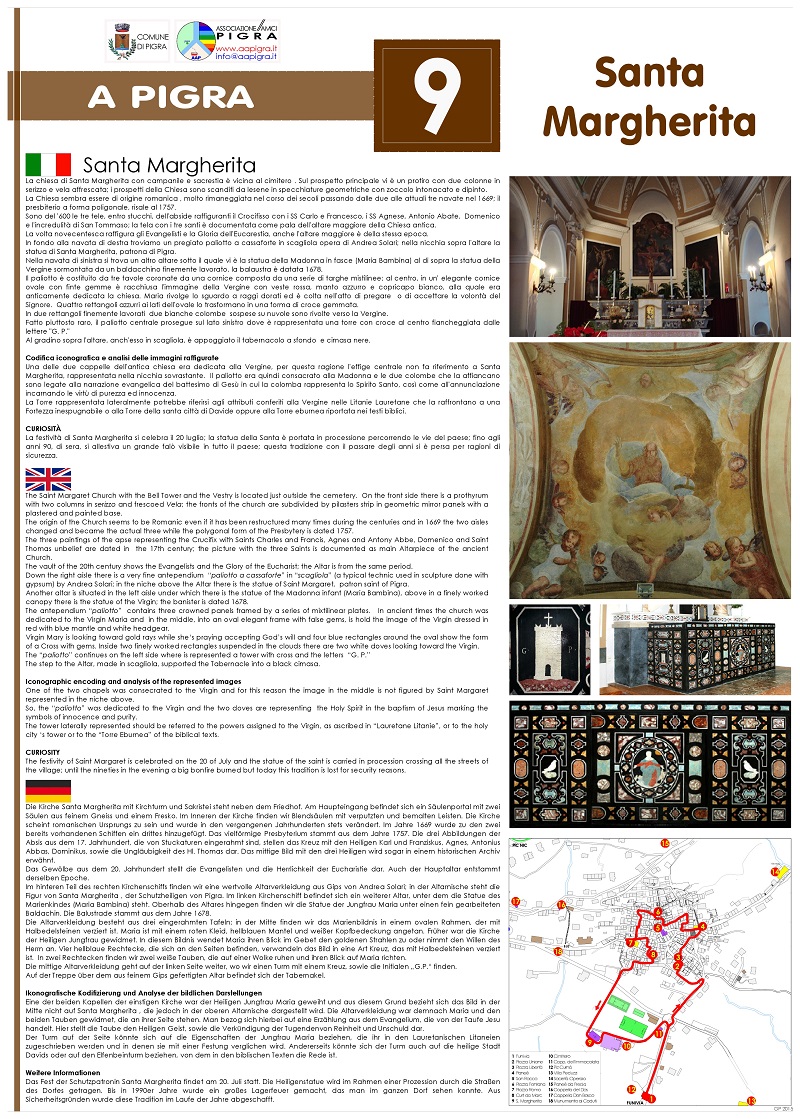
Pigra da Scoprire
6 - Piazza Fontana

La grande fontana è piena d’acqua fresca proveniente dalle fonti della montagna. In passato, prima del potenziamento dell’acquedotto della Valle, se era a secco testimoniava un periodo di particolare siccità.
La sera del 16 agosto anche Piazza Fontana è gremita dai Pigresi che non hanno trovato posto nella piazza San Rocco e sulle scalinate. E’ la sera dei CANESTRI, i cesti di funghi, torte, conigli, bottiglie di vino, banditi all’asta per le offerte alla Chiesa. Tradizione secolare per gli abitanti di Pigra. I banditori, divenuti famosi a Pigra quanto un fantino a Siena, conducono l’asta con memorabili urla in stretto Pigrese.
Sulla fontana troviamo un’altra statua di San Rocco, il santo venerato dai Pigresi insieme alla patrona Santa Margherita. Nato a Montpellier verso il 1350, nonostante le sue ricche origini, come San Francesco si spogliò dei suoi averi per dedicarsi al pellegrinaggio e alla cura dei poveri. E’ il santo protettore dal terribile flagello della peste che in quei tempi uccise un terzo della popolazione europea. Durante il suo lungo pellegrinaggio in Italia assistette i malati, che spesso venivano abbandonati anche dai familiari. Rimane il protettore dalle grandi epidemie come la peste, ma anche dalle malattie gravissime e l’AIDS. E’ anche protettore del mondo contadino e degli animali. In senso moderno è un grande esempio di solidarietà umana e carità cristiana, nel segno del volontariato.
Lo vediamo raffigurato secondo la sua tipica iconografia. Il vestito caratteristico del pellegrino con il mantellino che porta il suo nome “sanrocchino”, una zucca per contenere l’acqua, una piaga sulla coscia simbolo della lesione della peste, il cane con in bocca il pane (San Rocco fu sfamato da un cane che gli procurava ogni giorno un pane che si procurava dalla mensa di un nobile).

Nowadays the large fountain is full of fresh water, coming directly from mountain sources. In the past, before the aqueduct improvement in valle d'Intelvi, the lack of water inside the fountain was sign of a period of intense drought.
Every year, on 16th august,it is celebrated the so called 'la sera dei canestri'. Piazza fontana and the next flights of steps are usually crowded by Pigresi that can’t enter piazza st. Roch where Baskets full of fresh mushrooms, home made cakes, wine bottles, jam, vegetables and other typical products are sold by auction and the money collected is given as an offering to the church. It is a centuries-old tradition and the auctioneers, shouting in Pigrese dialect, are as famous in Pigra as the jockeys in Siena.
On the top of the fountain there is the statue of st.Roch venerated in Pigra along with st. Margherita the patroness of the village. Born in Montpellier around 1350 from a wealthy family, he devoted his life to the pilgrims and the poor, like the most famous st. Francesco. St.Roch Of Montpellier has been venerated as a protector from the plague that killed one-third of the european population in the middle ages. Today he is also venerated as a saint protector from contagious disease like aids. He is also the protector of travellers, farmers and animals….he is recognised as a symbol of Christian charity and voluntary work.
The statue represents him in accordance with the typical iconography: the distinctive dress of the pilgrim, a mantle named "sanrocchino", a pumpkin to hold water, a lesion on his thigh (symbol of the plague injury) and the count gothard's dog with a loaf of bread that it saved every day for the saint .
Heute ist der große Brunnen mit frischem Wasser aus den Bergquellen gefüllt. Früher, als das Aquädukt der Valle d’Intelvi noch nicht ausgebaut war, kam es vor, dass der Brunnen bei großer Dürre austrocknete.
Jedes Jahr, am Abend des 16. August, ist auch die Piazza Fontana von Pigresern überfüllt, die keinen Platz mehr auf der naheliegenden Piazza San Rocco und auf den angrenzenden Treppen gefunden haben. Am Abend des 16. August findet das Fest der Canestri statt: Körbe voller Pilze, Kuchen, Kaninchen und Weinflaschen werden zu Gunsten der Kirche versteigert. Dies ist für die Einwohner von Pigra eine hundertjährige Tradition. Die Versteigerer, die in Pigra so berühmt sind wie die Jockeys in Siena, bieten laut schreiend in tiefstem Pigreser Dialekt die Produkte an.
Auf dem Brunnen gibt es eine weitere Statue von San Rocco, der zusammen mit der Schutzpatronin Santa Margherita von den Pigresern verehrt wird. Der Heilige Rochus, geboren um 1350 in Montpellier, gab trotz seiner reichen Herkunft wie der Heilige Franziskus seine Besitztümer ab, um sich der Wallfahrt und den Armen zu widmen. Er ist der Schutzheilige vor der großen Geißel der Pest, die in jenen Tagen ein Drittel der europäischen Bevölkerung tötete.
Während seiner langen Wallfahrt in Italien stand er den Kranken bei, die häufig von ihren Familien ihrem Schicksal überlassen worden waren. Auch heute noch ist San Rocco der Schutzheilige vor den großen Epidemien wie die Pest aber auch vor schweren Krankheiten und AIDS. Er ist auch der Schutzherr der Bauern und der Tierwelt. Im modernen Sinn ist er ein großes Beispiel für menschliche Solidarität und christliche Nächstenliebe im Zeichen der Wohltätigkeit.
Wir sehen ihn mit seinen typischen Merkmalen: das Pilgerkleid mit dem Mäntelchen, das seinen Namen „sanrocchino“ trägt , der Kürbis als Wasserbehälter, die Narbe auf seinem Oberschenkel als Symbol der Pesterkrankung und der Hund mit Brot im Maul (San Rocco wurde von einem Hund ernährt, der ihm täglich Brot von der Tafel eines Adeligen brachte).
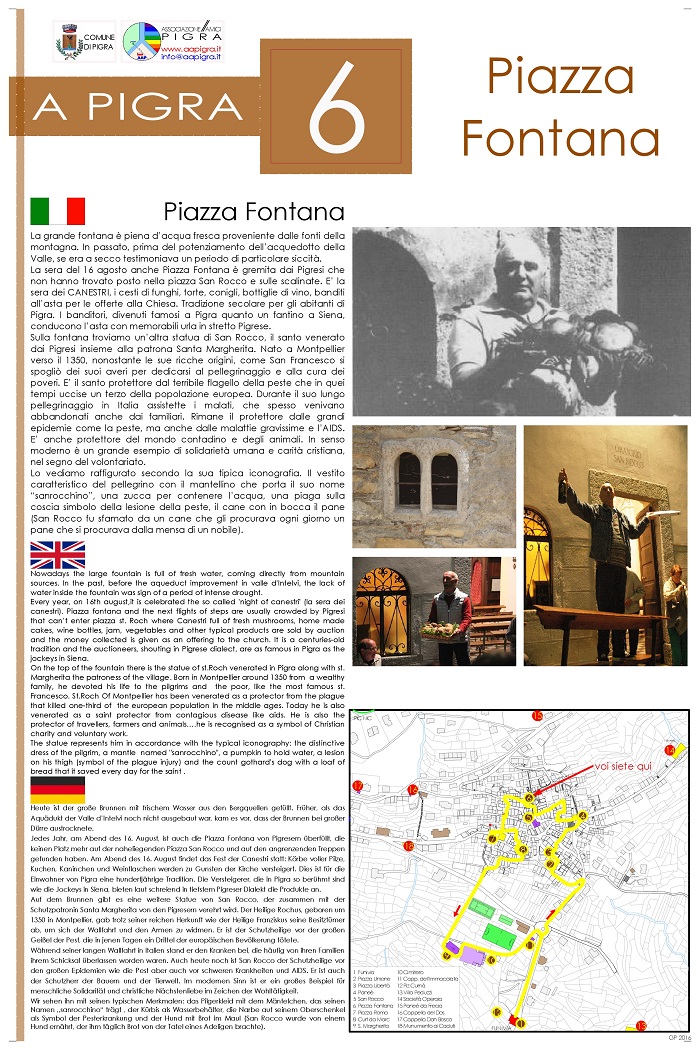
Pigra da Scoprire
8 - Curt da Marc

Nelle sere d’estate, all’ora di cena sulle panchine di sasso all’esterno di ogni casa sedevano spesso le donne di casa, con la scodella della minestra tra le mani. Tra le case vicine, da una panchina all’altra correva inevitabilmente la domanda: “Cuss’i fai ris e cussè?” (cosa avete fatto riso e cosa).
Non era curiosità, era partecipazione; e la domanda era obbligata nella sua formulazione perché non era pensabile che qualcuno avesse preparato la cena con una minestra diversa da quella di riso e latte. L’unica variabile era l’elemento complementare del riso. Ris daparlu (riso da solo); Ris e tartuful (riso e patate); Ris e burdon (riso e rape); Ris e fasoeu (riso e fagioli); Ris e pulenta (Riso e polenta); Ris e predesèe (riso e prezzemolo); Ris e zuca (riso e zuca); Ris a castègn (riso e castagne), ecc.
In tempo di guerra il colore della minestra “di latte” diventava azzurrino (culùu dal cièl), il che tradiva una presenza di latte più che simbolica.

In the summer evenings at dinner time, the women often were sat on the stone benches outside of each house, keeping the bowl of soup in their hands. Between the neighboring houses, a question ran bench by bench: "Cuss’i fai ris e cussè??" (What have you prepared, rice and what else?).
It was not curiosity, but it was emotional involvement; and the question was required exactly in that formulation because it was not possible that someone could make for dinner a soup different by the typical ‘rice and milk soup’. The only variable was the condiment of rice. Ris daparlu (rice); Ris e tartuful (rice with potatoes); Ris e burdon (rice with turnip); Ris e fasoeu (rice with bean); Ris e pulenta (Rice and polenta); Ris e predesèe (rice and parsley); Ris e zuca (rice and pumpkin); Ris a castègn (rice and chestnut), etc.
In time of war, the color of the "milk soup" became very light blue and it was defined by the citizen as “culùu dal cièl” (color of the sky), which indicated the presence of milk as a symbolic thing.
An den Sommerabenden saßen zur Essenszeit auf den Steinbänken vor den Häusern die Hausfrauen und hielten ihre Suppenschüsseln in den Händen. Zwischen dem einen und dem anderen Haus ging dann unweigerlich die Frage um: “Cuss’i fai ris e cussè?” (was habt ihr gemacht, Reis und was noch ?).
Es war nicht Neugier, sondern Anteilnahme; die Wortwahl war immer dieselbe, denn es war undenkbar, dass jemand eine andere Suppe zubereitet hätte als die mit Reis und Milch. Die einzige Variante war die weitere Zutat zum Reis. Ris daparlù (nur Reis); Ris e tartuful (Reis mit Kartoffeln); Ris e burdon (Reis mit Rüben); Ris e fasoeu (Reis mit Bohnen); Ris e pulenta (Reis mit Polenta); Ris e predesèe (Reis mit Petersilie); Ris e zuca (Reis mit Kürbis); Ris a castègn (Reis mit Kastanien) usw.
Während des Kriegs war die Farbe der Milchsuppe eher bläulich (culùu dal cièl – Farbe des Himmels), weil die Milch der Suppe nur noch den Namen gab.
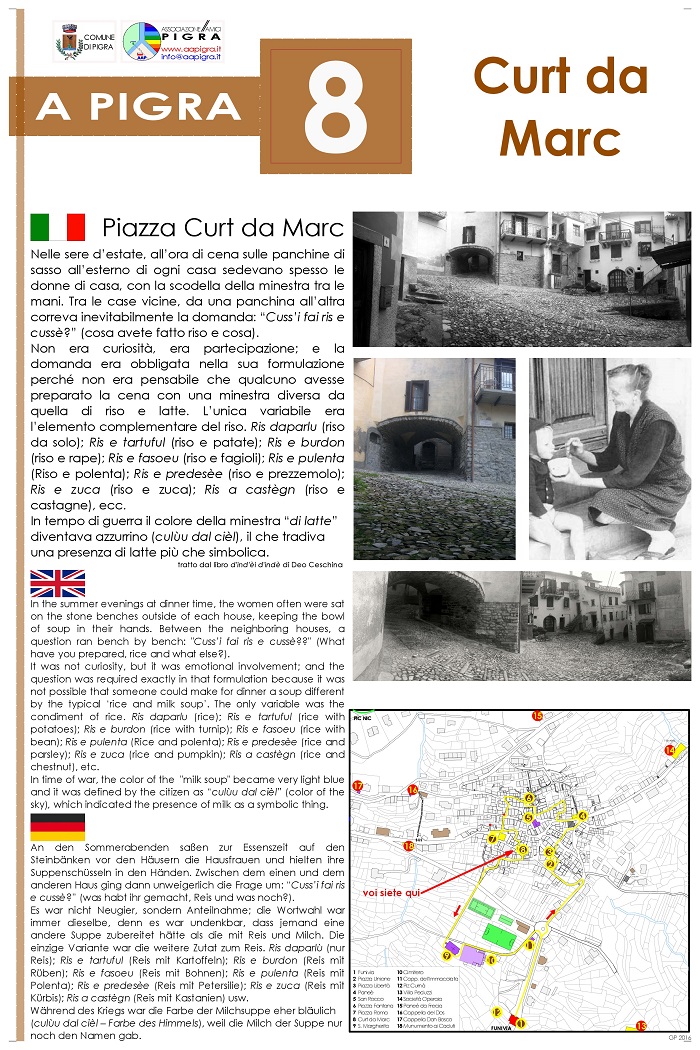

Associazione Amici di Pigra con il patrocinio del Comune di Pigra
Per favorire il flusso turistico a Pigra ed evitare che gli utenti della funivia si fermino nel solo piazzale contiguo oppure procedano direttamente per la strada asfaltata verso i rifugi montani, si è realizzato un percorso obbligato lungo le più belle vie ciottolate di Pigra.
Pigra da Scoprire
Il percorso si snoda partendo dalla funivia (1) verso la rotonda, per poi procedere dritto verso l'ex asilo, deviando a sinistra sulla strada ciottolata via Belvedere per poi entrare in piazza Unione (2) e sbucare in piazza Libertà (3 - ex Municipio).
Da qui si sale fino al Panèe da l'Alp (4) per poi passare nell'arco di vicolo erto ed arrivare a San Rocco (5) e piazza Fontana (6).
A lato della piazza si prende il volto di via xxxxxxx e si arriva in via Blessagno e poi in via XXV aprile per poi scendere giù in piazza Roma (7), una volta il centro della vita Pigrese.
Si passa poi in Curt da Marc (8) per poi deviare fino ad arrivare al ex bar/trattoria La Terrazza del Mucci. Scendendo progressivamente fino alla chiesa di Santa Margherita ed al piccolo cimitero.
